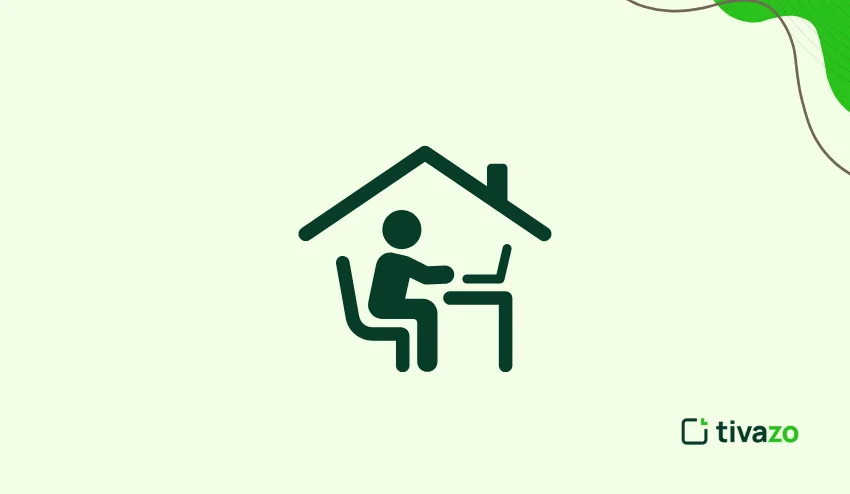Modern organizations—Tivazo included—have become adept at mobilizing talent across time zones, cultures, and continents. In this post, you’ll learn effective techniques for managing distributed teams, particularly for Agile, and real-world examples, and why Tivazo’s approach in the remote work revolution will distinguish us.
As the workplace makes an ever-greater shift to hybrid and fully remote models, the ability to lead and manage distributed teams is not a fad or specialty or a nice-to-have; it’s a business necessity. For any industry – software development, digital marketing, customer support – teams are now deployed in different countries, working asynchronously but expected to deliver synchronously. The upside is accessing diverse talent and being productive 24/7. The downside is a lack of communication, cultural disconnects, the inability to work cohesively together, and how to measure performance.
Here at Tivazo, we are turning these challenges into opportunities. With operations in Asia, the U.S., and Europe, we’ve built systems that not only support managing distributed teams but optimize them for Agile practices and tech stack and team bonding and happiness, and performance management – so you can confidently lead your distributed team with clarity.
Key Highlights:
- What Is a Distributed Team?
- Reasons Why Managing Distributed Teams is Important
- How to Look After Distributed Teams in Agile
- How to Manage Distributed Teams
- Comparing Key Practices
- Managing distributed teams: Examples.
What Is a Distributed Team?
A distributed team is defined as a team in which team members do not work in the same physical environment. Rather, they work in a remote fashion across multiple cities, states, countries, and sometimes, even continents. As part of the global talent workforce, distributed teams are growing in popularity, particularly in technology, marketing, and customer service.
Before diving into what it looks like to manage distributed teams, it is vital to understand how they differ from traditional teams:
- Geographical Location: Team members are dispersed over various locations, time zones, and usually culturally different places.
- Remote Collaboration: All team communication and project management is through digital tools like Slack, Zoom, project management tools (like Asana or Trello), and/or documentation (like Google Docs).
- Asynchronous Work: With geographical disparity comes a time zone difference. For productivity’s sake, teams often rely on processes that allow work to continue independently rather than require sequential processes for person-to-person completion.
- Diverse Perspectives: A key benefit of distributed teams is the sheer mixture of ideas, creative problem solving, and innovation representational of a multicultural team from several regions around the world.
- Technology Gap: More than ever, technology is driving collaboration. Whether it’s improving team and customer communication with Slack and Zoom, or cloud-based file storage and productivity tools that allow teams to be productive, it is imperative to function effectively.
At Tivazo, our teams are located in the U.S. and Europe, and our approach to managing distributed teams centers around supporting flexibility, accountability, and trust, so that everyone can work best, together.
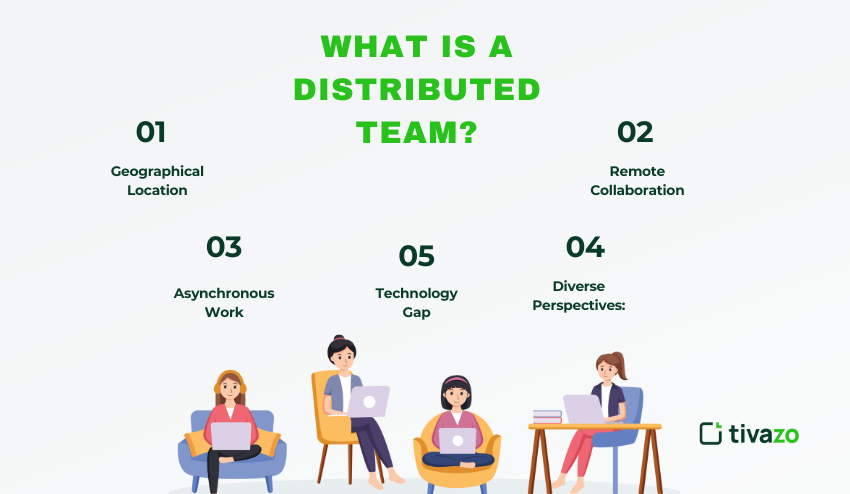
Reasons Why Managing Distributed Teams is Important
- It gives access to global talent – The world is your oyster as you are not limited to finding the best people where you are based.
- It allows work to continue 24/7 – If you have team members in different time zones, no matter where the office closes, work continues as projects are passed from one time zone to another along the journey.
- It saves costs and increases flexibility – An organization can save on relocation while allowing employees the flexibility to work from home or somewhere where they are most effective.
- It increases diversity and innovation – A globally distributed team means fresh ideas and solutions because of a greater variety of backgrounds, all of which can help get better business outcomes.
- It will allow rapid scale – Distributed teams will enable an organization to scale quickly without the need for physical expansion.
To be effective, a distribution team must be well managed to a) prevent isolation) miscommunication, and c) cultural friction. Poorly managed remote teams may be prone to missing timelines, low morale, and disrupted workflows.
At Tivazo, we have witnessed directly how principled approaches to managing distributed teams not only lead to the exploitation of a pent-up component of overheads, but they can also drive significant improvement in collaboration, innovation, and worker satisfaction. Our global reach continues to give us space to thrive in local markets while totally connected and motivated cohort of people working for us.
How to Look After Distributed Teams in Agile
1. Communicate goals
Agile depends on clarity: the roles of product owner, Scrum master, and development team should be established. This is crucial when looking after distributed teams
At Tivazo, we hold backlog grooming sessions before every sprint, and define our tasks through SMART goals—this is part of our layered looking after distributed teams methodology.
2. Communicate! Protocols: Synchronous and Asynchronous
Create a communications plan: use video for standups, Slack for chat, wikis for documentation, and synchronous and asynchronous methods of communicating to accommodate distant team members
Tivazo uses Zoom and Slack, and recorded Loom updates to enable looking after distributed teams in a flexible way across zones and managing distributed teams.
3. Flexibility for timezone
Conduct your daily scrum, sprint reviews, retrospective at your core hours of overlap, rotating times as necessary to support the team fairly
At Tivazo, we rotate our standups monthly—this way, no one person is always participating at odd times of day— it is a more equitable way of looking after managing distributed teams.
4. Technology stack & tools
There are many systems to consider in the use of Jira, Trello, Asana, GitHub, GitLab, Miro, and Confluence to promote all aspects of Agile and looking after distributed teams.
At Tivazo, we use Jira, which is integrated with Slack and Confluence, to automate
5. Trust, Autonomy & Culture
Foster autonomy in the team while having a clear feedback loop in place to avoid micromanagement, allow your team members to flourish in their roles, and create a trusting environment. This is paramount when managing distributed teams
Tivazo employs intrinsically motivated people and allows them to manage distributed teams and fulfill their requirements independently, where ‘independently’ doesn’t necessarily mean ‘without oversight’, which is essential for managing distributed teams respectively.
6. Retrospectives & Continuous Improvements
Remember to run sprint retrospectives often to identify progress made, to find issues, and to enhance the managing distributed teams effective method ITD Tech
We have a rule at Tivazo where we have retrospectives and then one-on-ones at every sprint commitment, and are therefore firm in our belief of implementing continuous improvements when managing distributed teams.
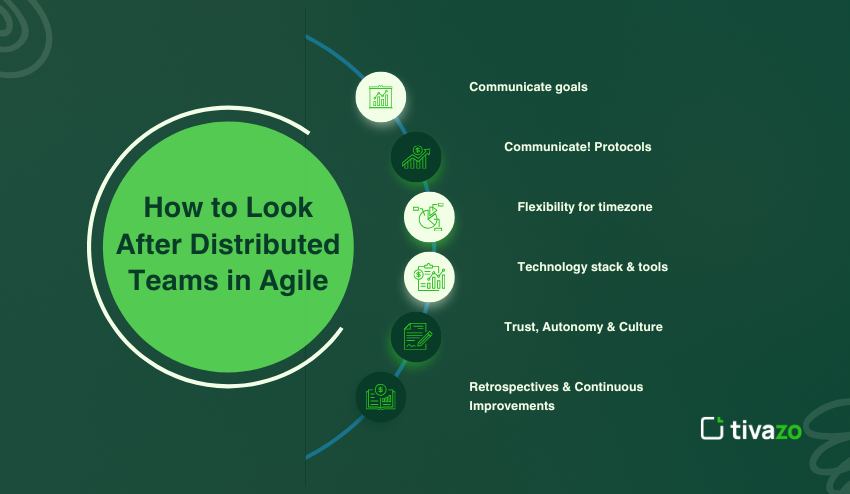
How to Manage Distributed Teams
Managing a remote workforce is not just relevant to Agile frameworks, but applies to teams in any capacity – sales, marketing, customer service, etc. There will always be delays in communication and challenges associated with time zones, but if you implement a structured approach, remote work and collaboration will be effective and efficient.
1. Communication and Transparency
As we all know, communication is the bedrock of any organizational success – it’s especially critical with distributed teams.
- You should use tools such as Slack, email, shared documents, and internal wikis, while allowing teams the freedom to determine which tools they prefer for communication and collaboration, as long as intended use is met.
- Establish clear expectations regarding response time for asynchronous communication so team members understand when they can expect a response, and do not keep waiting for a response without some follow-up.
- Regular status updates or centralized dashboards are effective ways to ensure information is spread equally and everyone has access to information from the same source.
These initiatives are important for any team across any number of different departments and locations.
2. Roles and Accountability
Again, without the face-to-face scenario, it’s even more critical to clarify expectations regarding roles and to provide accountability.
- You can use tools such as RACI matrices, org charts, or project briefs to provide clarity on who has responsibility for what, and how each person fits in the bigger picture.
- Providing this kind of clarity helps to eliminate overlap, reduce missed tasks, and improve overall efficiency.
3. Technologies & Automation
- Digital tools and automation assist you in managing distributed teams.
- Project management tools such as Asana, Trello, or ClickUp keep a record of work and make work manageable.
- Tools like Albato and Zapier can help automate repetitive tasks – think alerts, updates, and hand-offs.
The Reddit community frequently discusses the most useful PR notification bots and scheduled reminders to maintain efficiency when working remotely.
4. Team Connection & Well-being
- Social connection is just as relevant to remote work as getting the job done.
- Think about virtual hanging out, coffee chats, or Friday game days to create team culture.
- Encouraging work-related but not work-related Slack channels (for example: pets, music, fitness) can lead to the informal bonding of employees.
If it is feasible, gauge employee morale with anonymous feedback surveys.
Some of these non-technical interventions go a long way to combat isolation, decrease turnover, and create a more mentally healthy and happy workplace while managing distributed teams.
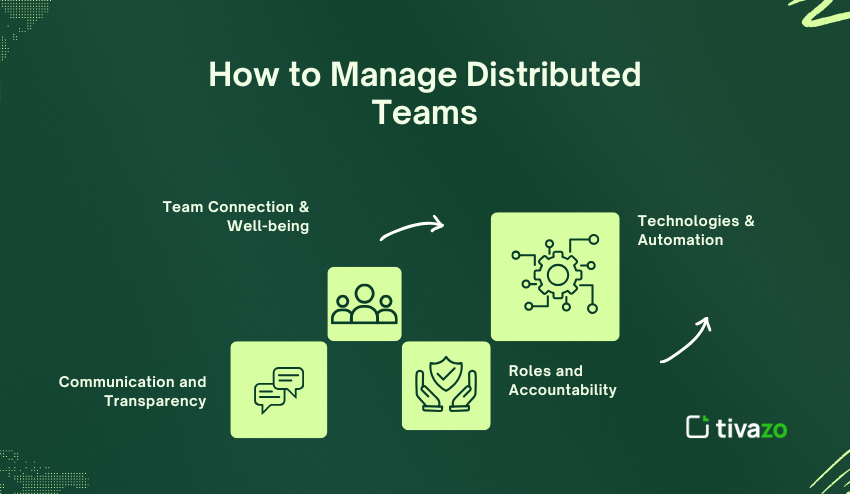
Comparing Key Practices
| Practice Area | Agile Context | Non‑Agile / Workforce Context |
| Defining Goals & Roles | Backlog Grooming, Scrum Roles | Using RACI Matrices and Job Descriptions |
| Communication | Daily Scrums, using Zoom + Loom, Rotated Standups | In Slack/email protocols, Expected response time |
| Tools | Jira, Git Hub, Miro, sprint dashboards | Asana, Trello, chatbots, shared docs |
| Dealing with time zones | Overlap hours, rotating meeting times | Core hours (window), flexible schedule |
| Culture & Bonding | Retrospectives, team feedback | Virtual events, recognition, one-on-ones |
| Continuous improvement | Sprint retrospectives, process tweaks | Regular reviews, discrete surveys, automated workflows, and adjustments |
Various Approaches for a distributed team
For most contemporary teams, especially at Tivazo, the best strategy for managing distributed teams is a combination of Agile discipline with flexible communication, good tools, and a human-centered culture. In particular:
- Agile frameworks can be applied even beyond engineering teams.
- Rotating meeting times and asynchronous updates allow for fairness.
- Automate your routine coordination (e.g., Slack bots, Jira rules).
- Build trust, autonomy, and frequent feedback loops.
- Foster social connection to combat remote fatigue.
Managing distributed teams: Examples.
One definite example of managing distributed teams is our cross-continental product sprint that involved our development team in Kathmandu, a UX designer in Europe, and a QA specialist in the U.S. on a significant feature release. We managed to create solid project deliverables and make sure communication was seamless by doing the following:
- Weekly grooming sessions for us to use Jira in prioritising and allocating tasks, and run important discussions around the features in the sprint.
- Daily standups with rotating times so that each team member could take turns and be fairly included in the communication and meet-ups.
- Using a Slack automation to announce pull request (PR) status updates and reminder alerts in a dedicated channel, so manual follow-up was not necessary.
- Zoom retrospectives with a camera-on policy to develop closer interpersonal relationships, and on occasion, we’d have informal chats following the retrospective to unwind on managing distributed teams.
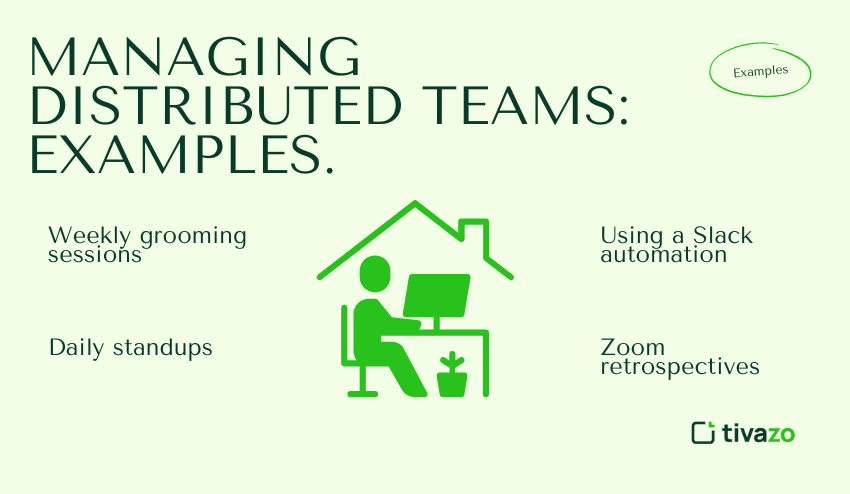
The sprint not only delivered the feature ahead of the sprint, but during our after-project survey, the sprint scored high in team satisfaction. To end, we had a virtual hangout with drinks and spotlighted the sprint recognition in Tivazo’s internal newsletter. It was a practice we continued to enhance our remote-team culture.
Another great piece of work was a remote marketing campaign. Our designers, content writers, and data analysts in several countries across Asia and North America worked together to launch a multi-channel campaign with everybody contributing at different points along the way. We used Confluence to designate roles (using a RACI matrix) and Asana to develop the timeline, then used threads in Slack for writing group accountability on daily progress. We get together virtually, via video, weekly during the campaign to remove blockers, and then a few minutes discussing creativity or creative testing in the moment, to managing distributed teams.
We also rolled out highly sensitive solutions, using Google Drive for sharing, Canva for creating images, and SEMrush, each paired with integrations, so that everybody was able to stay connected to each other, where they were and what was happening with the analytical content as we approached the deadline. Even though managing distributed teams were spread out, everyone knew who was accountable for what, and the group communicated well as a group.
The decentralized team engagement was a fantastic example of the distributed model that I see, to create high-quality outcomes without the limitations that can sometimes come with geography of an office, e.g., communication and automation processes and systems, and was again a demonstrated experience of autonomy and trusted culture, in addition to autonomy and being the right tool and world view to leverage within a distributed network.
Conclusion
Effectively managing distributed teams is no longer a competitive edge for organizations; it is now a requirement of a global work environment. There are several methods to ensure that communication, accountability, technology, and team culture align in a way that enables organizations to overcome time zone differences and foster effective collaboration. Whether you’re managing an Agile sprint in a single time zone or have a remote workforce around the world, you just need to be intentional with the processes and flexible about how they are executed. At Tivazo, our proven methods for managing distributed teams have allowed us to unleash creativity, increase productivity, and experience robust team morale, so any organization can adapt to a distributed setup!

